Evolution of System Embedded Optical Interconnect in Sub-Top-of-Rack Data Center Systems
Abstract
:1. Introduction
2. Midboard Optical Transceivers
2.1. Midboard Optical Transceivers
2.2. Low Port-Count Optical Transceivers
3. LightningValley—First-Generation Optically Enabled Data Center System
3.1. Optically Enabled Data Storage Switch Controller Daughtercards with Polymer Waveguide Interconnect
3.2. Polymer Interconnect Measurement Set-Up and Results
- (a)
- An optical signal generated in the BOA module on the first controller daughtercard couples into the 2 × 12 MT compliant ferrule of the first S-curved polymer waveguide flexible cable.
- (b)
- The signal propagates along the first S-curved flexible polymer waveguide cable.
- (c)
- At the card edge, the optical signal couples into the 2 × 12 MT compliant ferrule of the straight midplane polymer waveguide flex through the Huber + Suhner FiberGate connector.
- (d)
- The signal propagates along the midplane polymer waveguide flex from the first daughtercard location to the second controller daughtercard location.
- (e)
- The signal couples into the 2 × 12 MT compliant ferrule of the second S-curved flexible polymer waveguide cable through the FiberGate connector on the second controlled daughtercard.
- (f)
- The signal propagates along the second S-curved flexible polymer waveguide cable.
- (g)
- The signal couples into the optical interface of the BOA module on the second controller daughtercard.
4. ThunderValley2—Second-Generation Optically Enabled Data Center System
4.1. Optically Enabled Data Storage Switch Controller Daughtercards with Fiber Interconnect
4.2. Electro-Optical Midplane
4.3. Optical Disk Drive Interface Card
4.4. Optical Disk Drive “MorningStar” Connector
5. Pegasus—Third-Generation Optically Enabled Data Center System
Optical End Node Connector Interface
6. Aurora—Hyperscale Integrated Optical and Photonics Ecosystem Demonstrator Platform
7. Nexus—Fully Converged Rack-Scale Data Center Test Platform
8. Copackaged Optical Assembly—The Ultimate Migration of System-Level Optical Interconnect
9. Conclusions and Further Work
Author Contributions
Funding
Institutional Review Board Statement
Informed Consent Statement
Data Availability Statement
Conflicts of Interest
References
- Mahajan, R.; Li, X.; Fryman, J.; Zhang, Z.; Nekkanty, S.; Tadayon, P.; Jaussi, J.; Shumarayev, S.; Agrawal, A.; Jadhav, S.; et al. Co-Packaged Photonics for High Performance Computing: Status, Challenges and Opportunities. J. Light. Technol. 2021, 40, e3104725. [Google Scholar] [CrossRef]
- Fathololoumi, S.; Nguyen, K.; Mahalingam, H.; Sakib, M.; Li, Z.; Seibert, C.; Montazeri, M.; Chen, J.; Doylend, J.K.; Jayatilleka, H.; et al. 1.6 Tbps Silicon Photonics Integrated Circuit for Co-Packaged Optical-IO Switch Applications. In Proceedings of the Optical Fiber Communication Conference (OFC), San Diego, CA, USA, 13 March 2020; p. T3H.1. [Google Scholar]
- Liao, L.; Fathololoumi, S.; Hui, D. High Density Silicon Photonic Integrated Circuits and Photonic Engine for Optical Co-packaged Ethernet Switch. In Proceedings of the 2020 European Conference on Optical Communications (ECOC), Brussels, Belgium, 20–24 September 2020; pp. 1–4. [Google Scholar] [CrossRef]
- Schmidtke, K.; Flens, F.; Worrall, A.; Pitwon, R.; Betschon, F.; Lamprecht, T.; Kraehenbuehl, R. 960 Gb/s optical backplane using embedded polymer waveguides and demonstration in a 12G SAS storage array. In Proceedings of the 2013 Optical Interconnects Conference, Santa Fe, NM, USA, 5–8 May 2013; pp. 29–30. [Google Scholar] [CrossRef]
- Pitwon, R.; Worrall, A.; Stevens, P.; Miller, A.; Wang, K.; Schmidtke, K. Demonstration of fully enabled data center subsystem with embedded optical interconnect. In Proceedings of the Optical Interconnects Xiv, San Francisco, CA, USA, 8 March 2014; Volume 8991, p. 899110. [Google Scholar] [CrossRef]
- Pitwon, R.C.; Immonen, M.; Schroeder, H.; Neitz, M.; Wang, K. Universal test system for system embedded optical interconnect. In Proceedings of the SPIE—The International Society for Optical Engineering, San Francisco, CA, USA, 22 February 2018; Volume 10538, p. 1053804. [Google Scholar]
- Pitwon, R.; O’Faolain, L. Modular test system for high-speed silicon photonics transceivers. In Proceedings of the SPIE—The International Society for Optical Engineering, San Francisco, CA, USA, 4 March 2019; Volume 10924, p. 109240I. [Google Scholar]
- Pitwon, R.; Wang, K.; Worrall, A. Converged photonic data storage and switch platform for exascale disaggregated data centers. In Proceedings of the SPIE—The International Society for Optical Engineering, San Francisco, CA, USA, 20 February 2017; Volume 10109. [Google Scholar] [CrossRef]
- Ghiasi, A.; Nowell, M.; Sommers, S. QSFP-DD/QSFP-DD800/QSFP112 Hardware Specification for QSFP DOUBLE DENSITY 8X AND QSFP 4X PLUGGABLE TRANSCEIVERS. QSFD-DD MSARevision 6.0128 May 2021. Available online: http://www.qsfp-dd.com/wp-content/uploads/2021/05/QSFP-DD-Hardware-Rev6.01.pdf (accessed on 15 October 2021).
- Schmidtke, K.; Flens, F. Trends and Future Directions in Optical Interconnects for Datacenter and Computer Applications. In Proceedings of the Optical Fiber Communication Conference Postdeadline Papers; The Optical Society: San Diego, CA, USA, 2010; p. OTuP4. [Google Scholar]
- Schmidtke, K.E.; Flens, F.; Mahgarefteh, D. Taking Optics to the Chip: From Board-mounted Optical Assemblies to Chip-level Optical Interconnects. In Proceedings of the Optical Fiber Communication Conference, San Francisco, CA, USA, 9 March 2014; pp. 1–3. [Google Scholar]
- Maniotis, P.; Terzenidis, N.; Siokis, A.; Christodoulopoulos, K.; Varvarigos, E.; Immonen, M.; Yan, H.J.; Zhu, L.X.; Hasharoni, K.; Pitwon, R.; et al. Application-Oriented On-Board Optical Technologies for HPCs. J. Light. Technol. 2017, 35, 3197–3213. [Google Scholar] [CrossRef]
- Schmidtke, K.; Flens, F.; Worrall, A.; Pitwon, R.; Betschon, F.; Lamprecht, T.; Krahenbuhl, R. 960 Gb/s Optical Backplane Ecosystem Using Embedded Polymer Waveguides and Demonstration in a 12G SAS Storage Array. J. Light. Technol. 2013, 31, 3970–3975. [Google Scholar] [CrossRef]
- Flens, F. Fiber Optics Packaging. In Proceeding of the Optical Fiber Communication Conference, Los Angeles, CA, USA, 22–26 March 2015; Paper Th1G.4; Optica Publishing Group: Washington, DC, USA, 2015. [Google Scholar]
- Telcordia. Generic Reliability Assurance Requirements for Passive Optical Components. 2010. Available online: https://telecom-info.njdepot.ericsson.net/ido/AUX/GR_1221_TOC.i02.pdf (accessed on 15 October 2021).
- Kruse, K.; Middlebrook, C. Laser-direct writing of single mode and multi-mode polymer step index waveguide structures for optical backplanes and interconnection assemblies. Photonics Nanostruct.-Fundam. Appl. 2015, 13, 66–73. [Google Scholar] [CrossRef]
- Nawata, H.; Oshima, J.; Kashino, T. Organic-inorganic hybrid material SUNCONNECT(R) for photonic integrated circuit. In Optical Interconnects XVIII; International Society for Optics and Photonics: Bellingham, WA, USA, 2018; Volume 10538, pp. 70–78. [Google Scholar] [CrossRef]
- Pitwon, R.C.A.; Brusberg, L.; Schroder, H.; Whalley, S.; Wang, K.; Miller, A.; Stevens, P.; Worrall, A.; Messina, A.; Cole, A. Pluggable Electro-Optical Circuit Board Interconnect Based on Embedded Graded-Index Planar Glass Waveguides. J. Light. Technol. 2014, 33, 741–754. [Google Scholar] [CrossRef]
- Tokas, K.; Spatharakis, C.; Patronas, I.; Bakopoulos, P.; Landi, G.; Christodoulopoulos, K.; Capitani, M.; Kyriakos, A.; Aziz, M.; Pitwon, R.; et al. Real Time Demonstration of an End-to-End Optical Datacenter Network with Dynamic Bandwidth Allocation. In Proceedings of the 44th European Conference on Optical Communication-ECOC, Rome, Italy, 23–27 September 2018; pp. 1–3. [Google Scholar]
- Pitwon, R.; Miller, A. Optical Connectors. U.S. Patent 10,732,360, 4 August 2020. [Google Scholar]
- Kurata, K.; Pitwon, R. Short reach, low cost silicon photonic micro-transceivers for embedded and co-packaged system integration. In Proceedings of the Optical Interconnects XX, San Francisco, CA, USA, 1–6 February 2020. [Google Scholar]
- Pitwon, R.; O’Faolain, L.; Kurata, K.; Lee, B.; Ninomyia, T. Hyperscale Integrated Optical and Photonic Interconnect Platform. In Proceedings of the 2020 IEEE Photonics Conference (IPC), Vancouver, BC, Canada, 28 September–1 October 2020. [Google Scholar] [CrossRef]
- Pitwon, R. System embedded photonic interconnect for mega-data centre environments. In Proceedings of the 2016 IEEE CPMT Symposium Japan (ICSJ), Kyoto, Japan, 7–9 November 2016; pp. 87–90. [Google Scholar] [CrossRef] [Green Version]
- Fraunhofer, I.Z.M. Press Release PhoxTroT: Optical Interconnect Technologies Revolutionized Data Centers and HPC Systems. Available online: http://www.phoxtrot.eu/press-release/ (accessed on 23 December 2017).
- National Technical University of Athens. Nephele Project. Available online: http://www.nepheleproject.eu (accessed on 8 December 2015).
- CEA-LETI. Horizon 2020 COSMICC Project. Available online: http://www.h2020-cosmicc.com (accessed on 15 October 2021).
- Hakansson, A.; Tekin, T.; Brusberg, L.; Pleros, N.; Vyrsokinos, C.; Apostolopoulos, D.; Pitwon, R.; Miller, A.; Wang, K.; Tulli, D.; et al. PhoxTroT—A European initiative toward low cost and low power photonic interconnects for data centres. In Proceedings of the 2015 17th International Conference on Transparent Optical Networks, Budapest, Hungary, 5–9 July 2015; pp. 1–5. [Google Scholar]
- Bakopoulos, P.; Christodoulopoulos, K.; Landi, G.; Aziz, M.; Zahavi, E.; Gallico, D.; Pitwon, R.; Tokas, K.; Patronas, I.; Capitani, M.; et al. NEPHELE: An End-to-End Scalable and Dynamically Reconfigurable Optical Architecture for Application-Aware SDN Cloud Data Centers. IEEE Commun. Mag. 2018, 56, 178–188. [Google Scholar] [CrossRef]
- Stone, R.; Chen, R.; Rahn, J.; Venkataraman, S.; Wang, X.; Schmidtke, K.; Stewart, J. Co-packaged Optics for Data Center Switching. In Proceedings of the 2020 European Conference on Optical Communications (ECOC), Brussels, Belgium, 6–10 December 2020; pp. 1–3. [Google Scholar] [CrossRef]
- Pitwon, R.; Yamauchi, A.; Brusberg, L.; Wang, K.; Ishigure, T.; Neitz, M.; Worrall, A. Planar polymer and glass graded index waveguides for data center applications. Opt. Interconnects XVI 2016, 9753, 97530. [Google Scholar] [CrossRef]
- Kurata, K.; Hagihara, Y.; Kurihara, M.; Yashiki, K.; Kinoshita, K.; Shiba, K.; Kuwata, M.; Muto, T.; Kobayashi, S.; Baba, N.; et al. Short reach, high temperature operation and high reliability silicon photonic micro-transceivers for embedded and co-packaged system integration. In Optical Interconnects XXI; SPIE: Bellingham, WA, USA, 2021; Volume 11692, p. 1169204. [Google Scholar]
- Kurata, K.; Giorgi, L.; Cavaliere, F.; O’Faolain, L.; Schulz, S.A.; Nishiyama, K.; Hagihara, Y.; Yashiki, K.; Muto, T.; Kobayashi, S.; et al. Silicon Photonic Micro-Transceivers for Beyond 5G Environments. Appl. Sci. 2021, 22, 10955. [Google Scholar] [CrossRef]
- Olivier, S.; Sciancalepore, C.; Hassan, K.; Fowler, D.; Ben Bakir, B.; Ferroti, T.; Duprez, H.; Durel, J.; Abraham, A.; Plantier, S.; et al. Silicon photonic transceivers for beyond 1-Tb/s datacom applications (Conference Presentation). In Optical Interconnects XVII; SPIE: Bellingham, WA, USA, 2017; Volume 10109, p. 101090. [Google Scholar] [CrossRef]
- Consortium For On-Board Optics. Trends in Optical Networking Communications. 2020. Available online: https://0175c8a8-ec1a-451d-86d7-8291b141a6cb.filesusr.com/ugd/7bc1dc_66d86c38c1d54d04992bec153d6359a0.pdf (accessed on 15 October 2021).
- 2 Tb/s Copackaged Optics Optical Module Product Requirements Document. 2021. Available online: http://www.copackagedoptics.com/wp-content/uploads/2021/02/JDF-3.2-Tb_s-Copackaged-Optics-Module-PRD-1.0.pdf (accessed on 15 October 2021).
- Amano, T.; Noriki, A.; Tamai, I.; Ibusuki, Y.; Ukita, A.; Suda, S.; Kurosu, T.; Takemura, K.; Aoki, T.; Shimura, D.; et al. Polymer Waveguide-coupled Co-packaged Silicon Photonics-die Embedded Package Substrate. In Proceedings of the Optical Fiber Communication Conference (OFC) 2021, Washington, DC, USA, 7 June 2021; p. Th4A.1. [Google Scholar]
- Brusberg, L.; Grenier, J.R.; Matthies, J.; Miller, A.M.; Terwilliger, C.C.; Clark, J.S.; Zeng, B.; Beneke, P. Passive Aligned Glass Waveguide Connector for Co-Packaged Optics. In Proceedings of the 2021 European Conference on Optical Communication (ECOC), Bordeaux, France, 23–25 September 2021; pp. 1–4. [Google Scholar]
- Brusberg, L.; Zakharian, A.R.; Kocabas, S.E.; Yeary, L.W.; Grenier, J.R.; Terwilliger, C.C.; Bellman, R.A. Glass Substrate with Integrated Waveguides for Surface Mount Photonic Packaging. J. Light. Technol. 2021, 39, 912–919. [Google Scholar] [CrossRef]
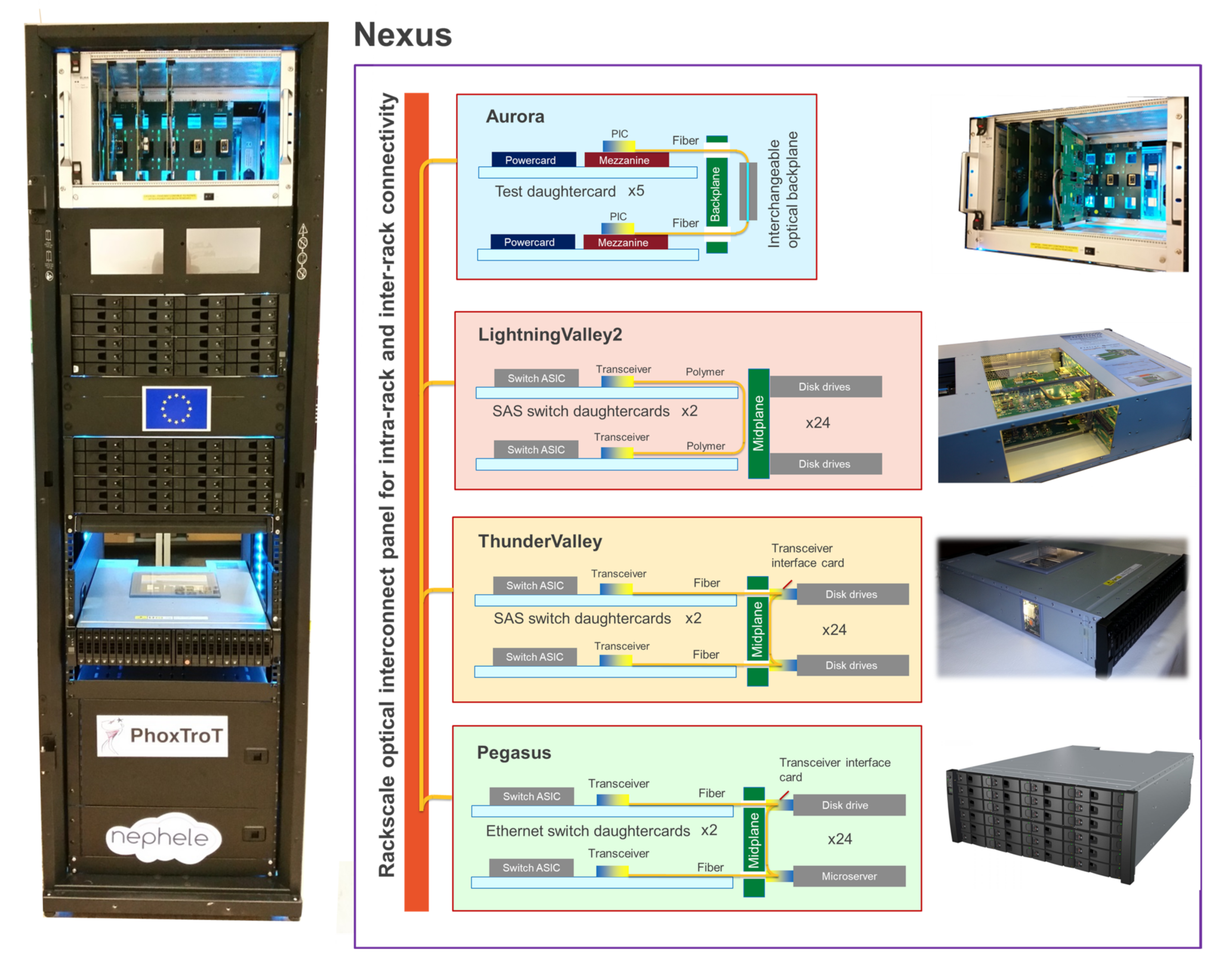

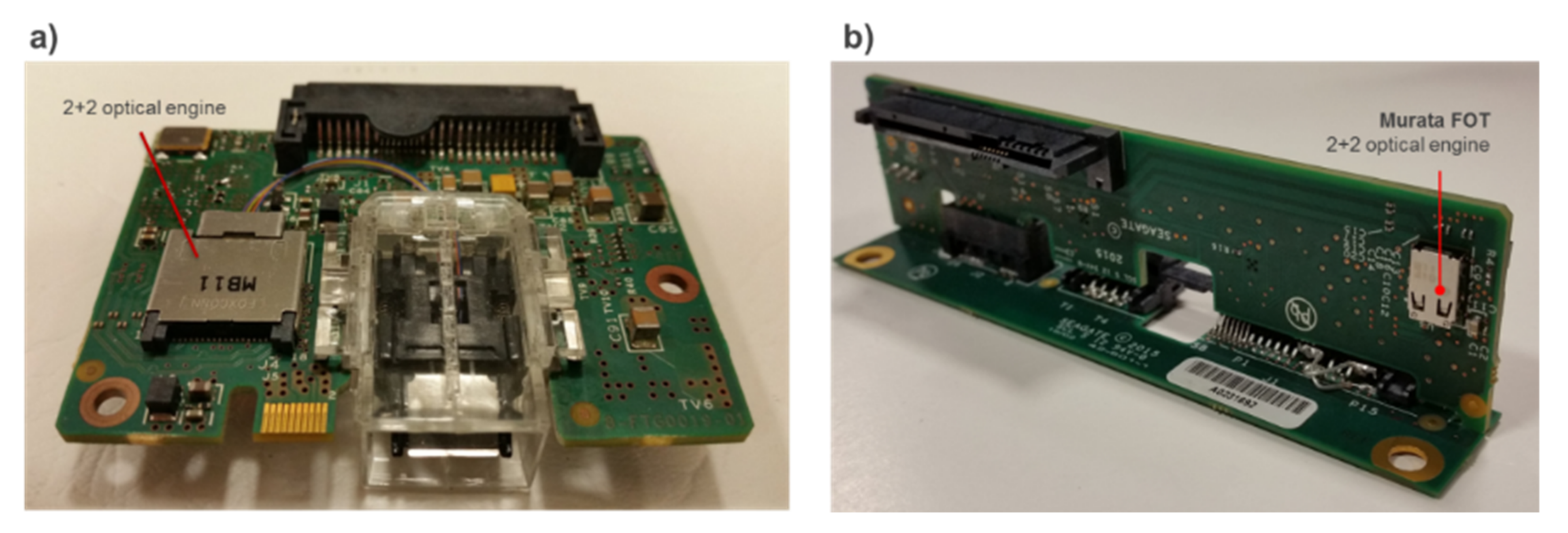


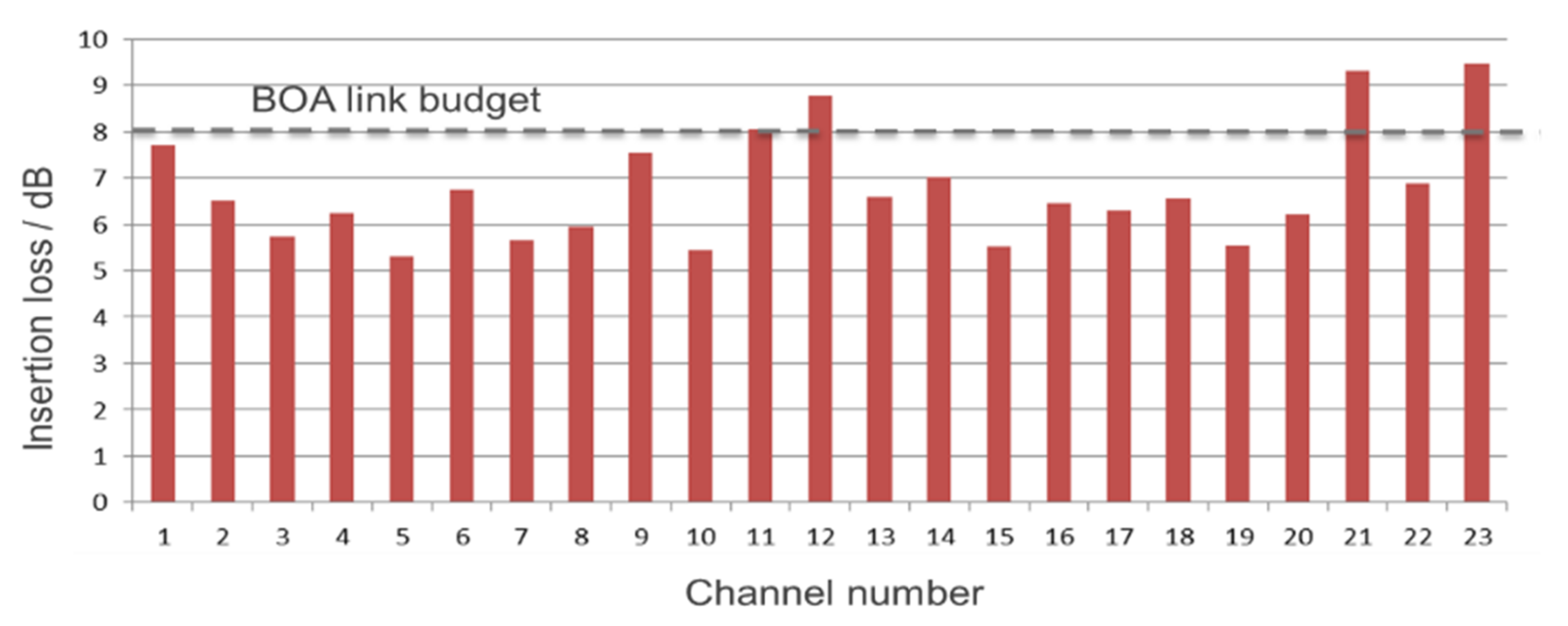
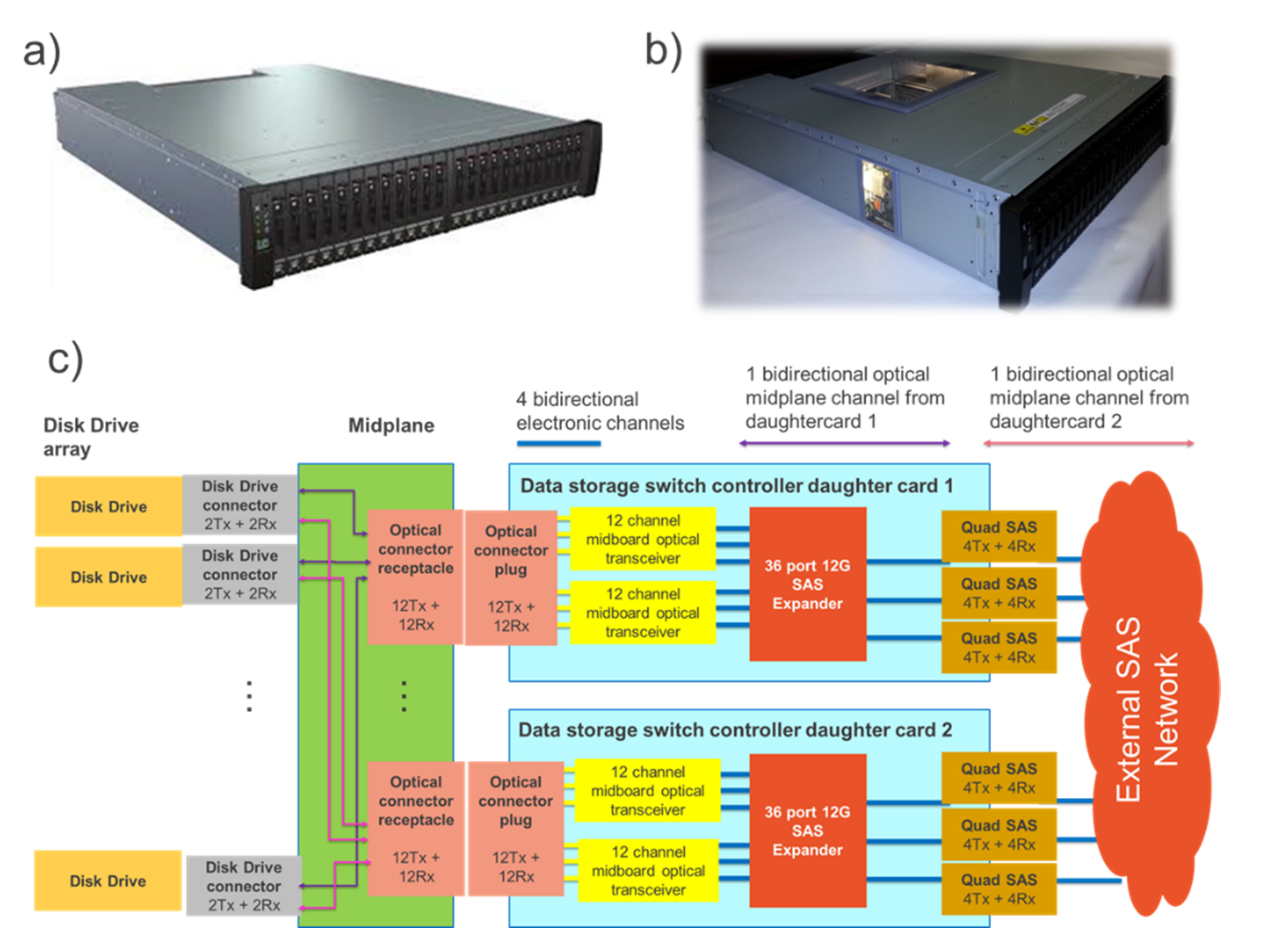
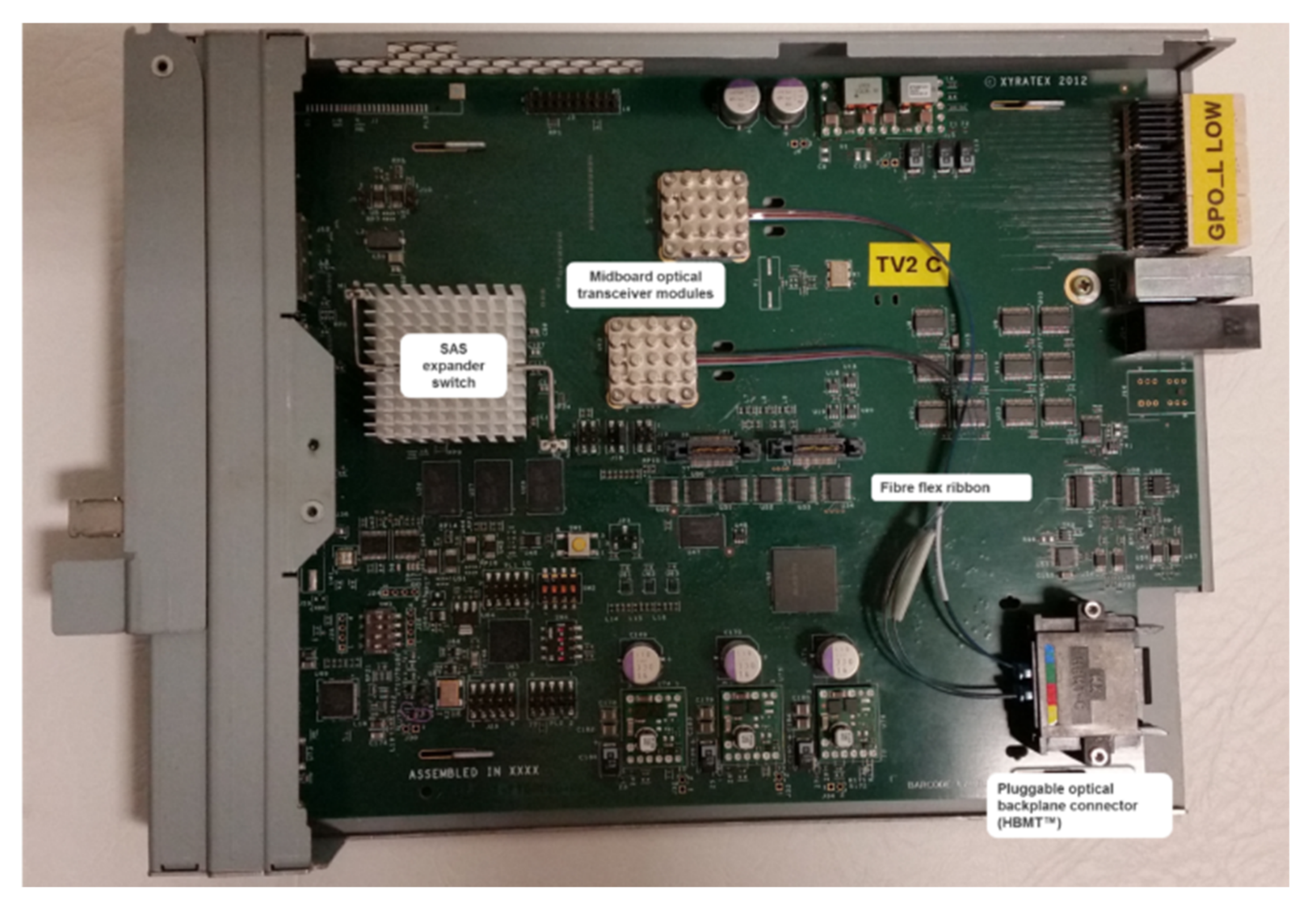

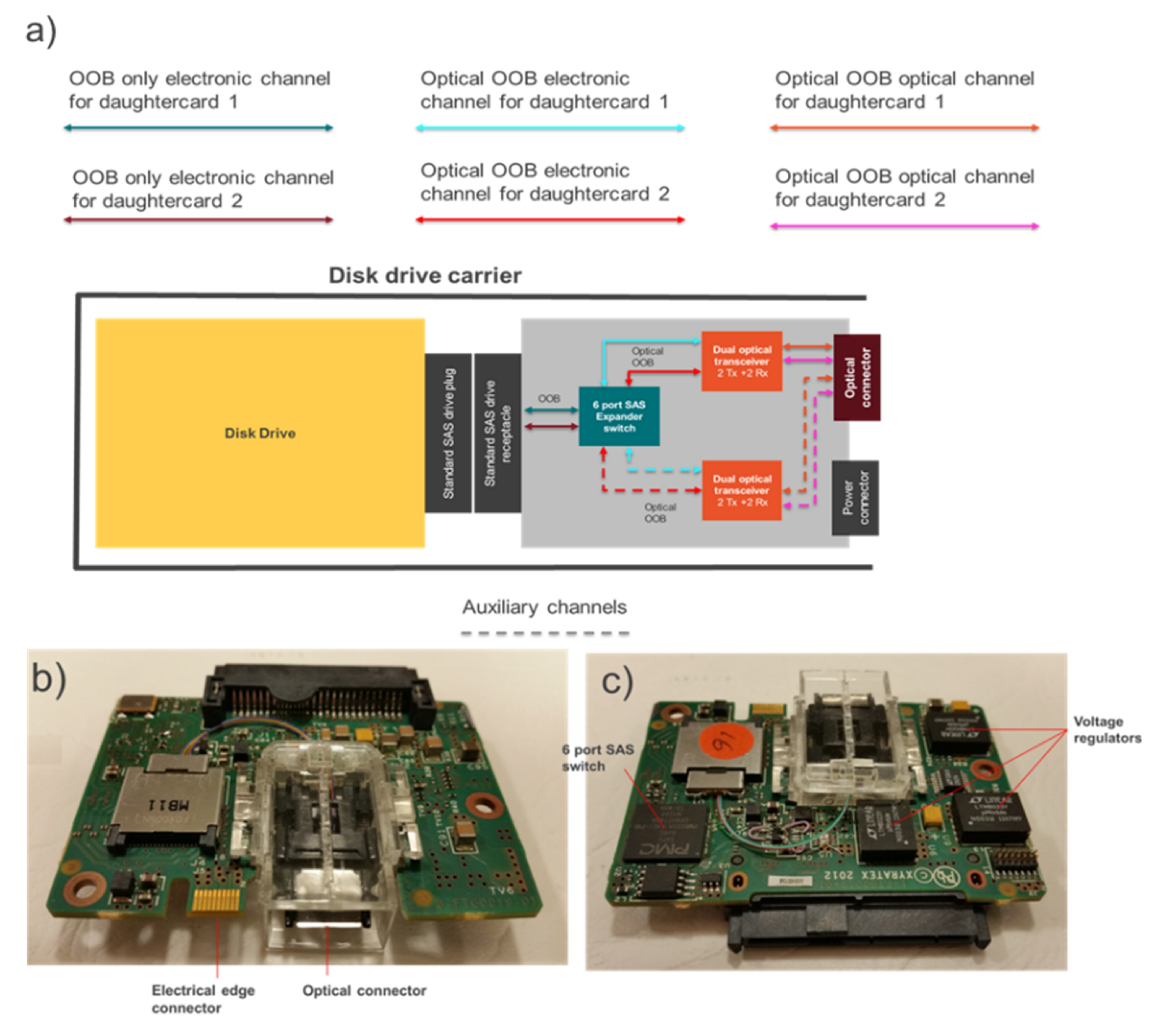
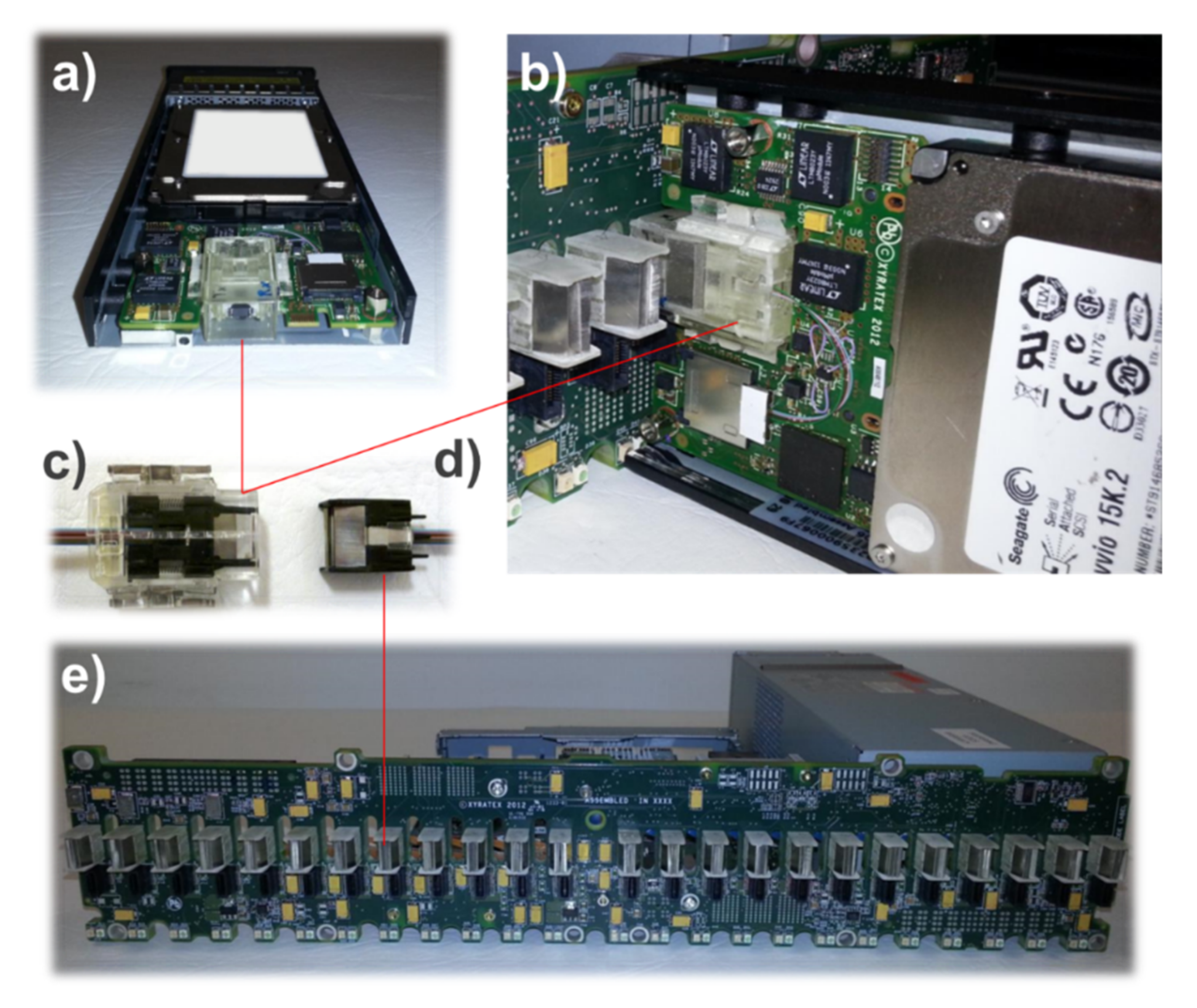
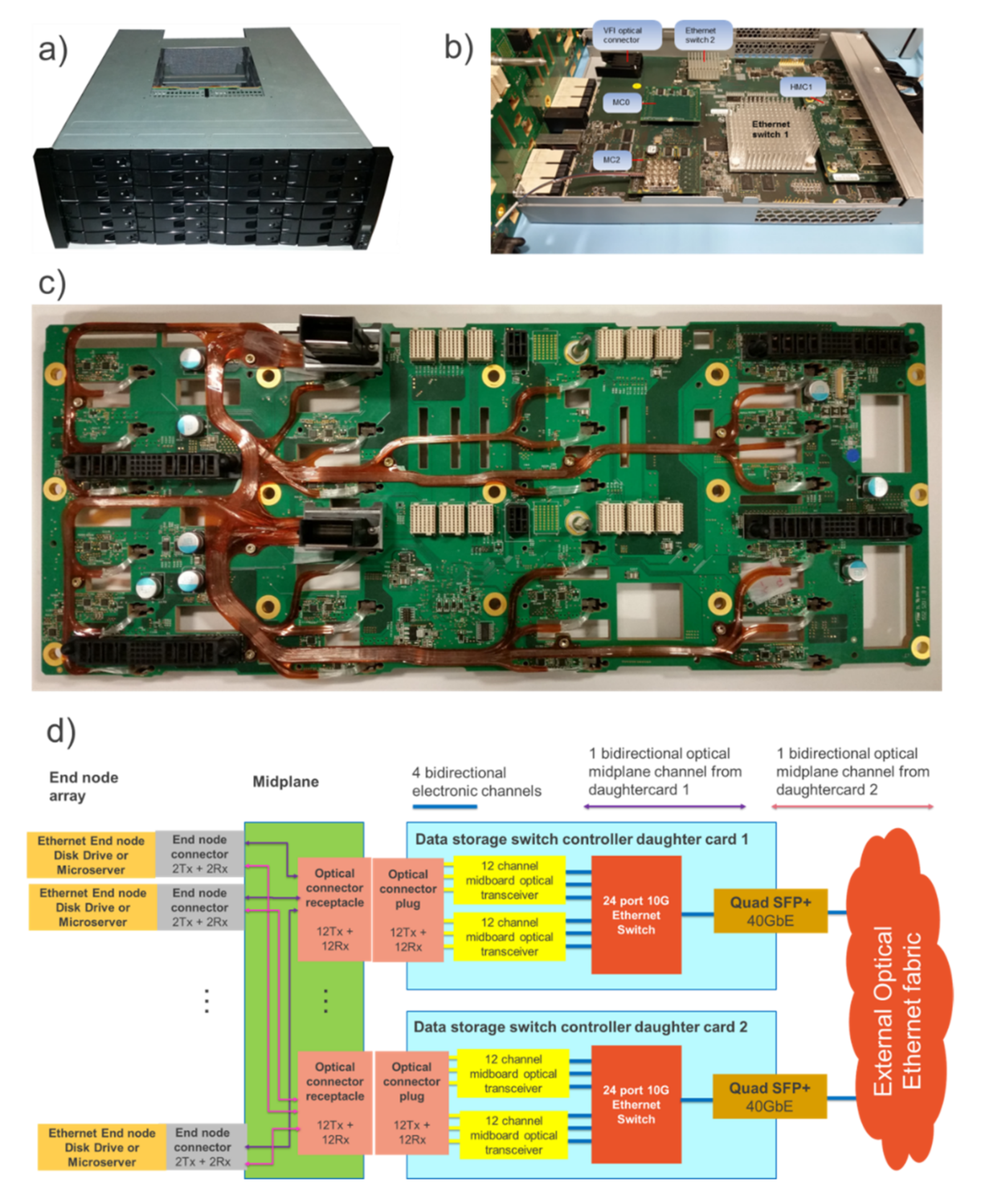

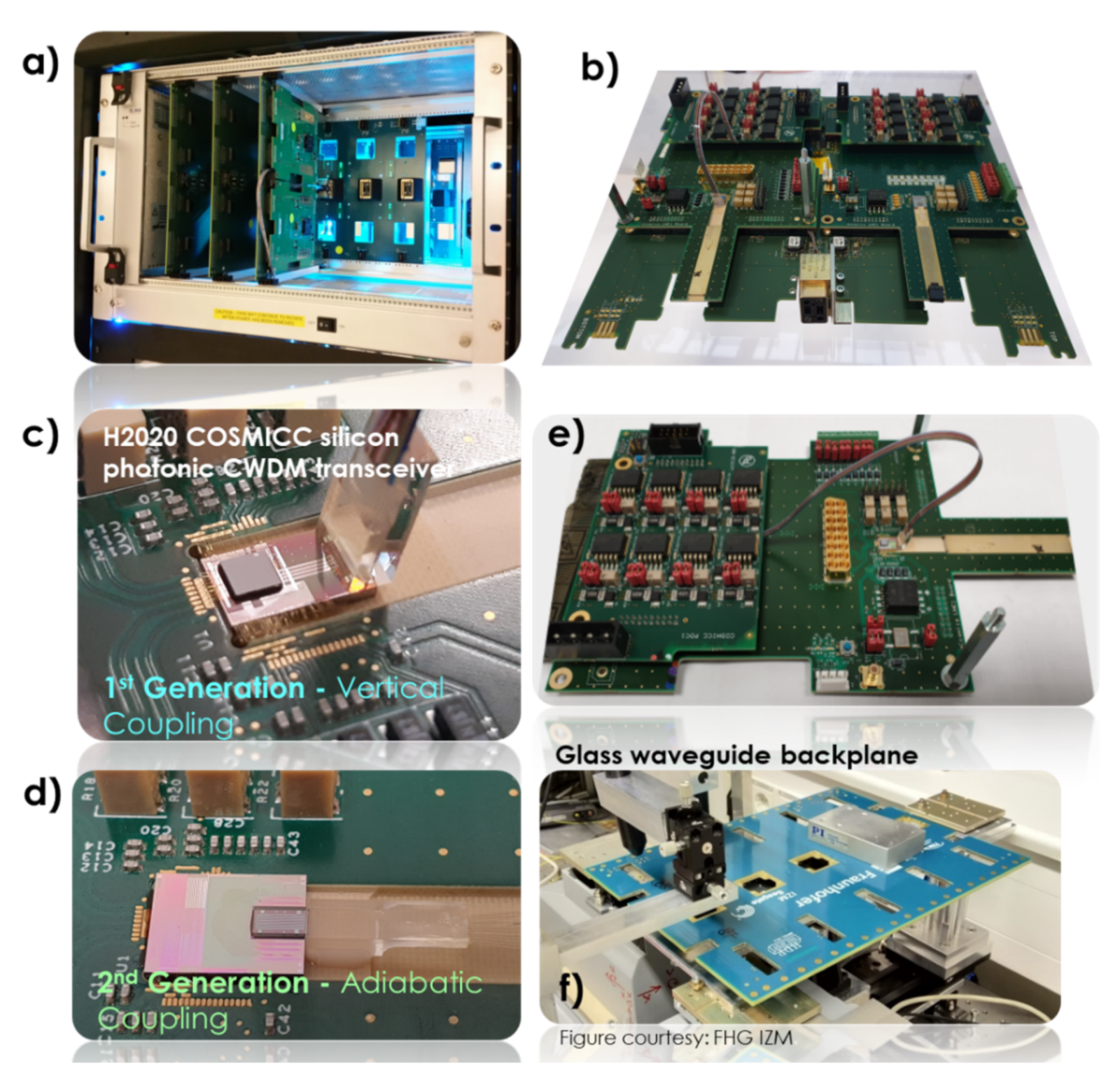
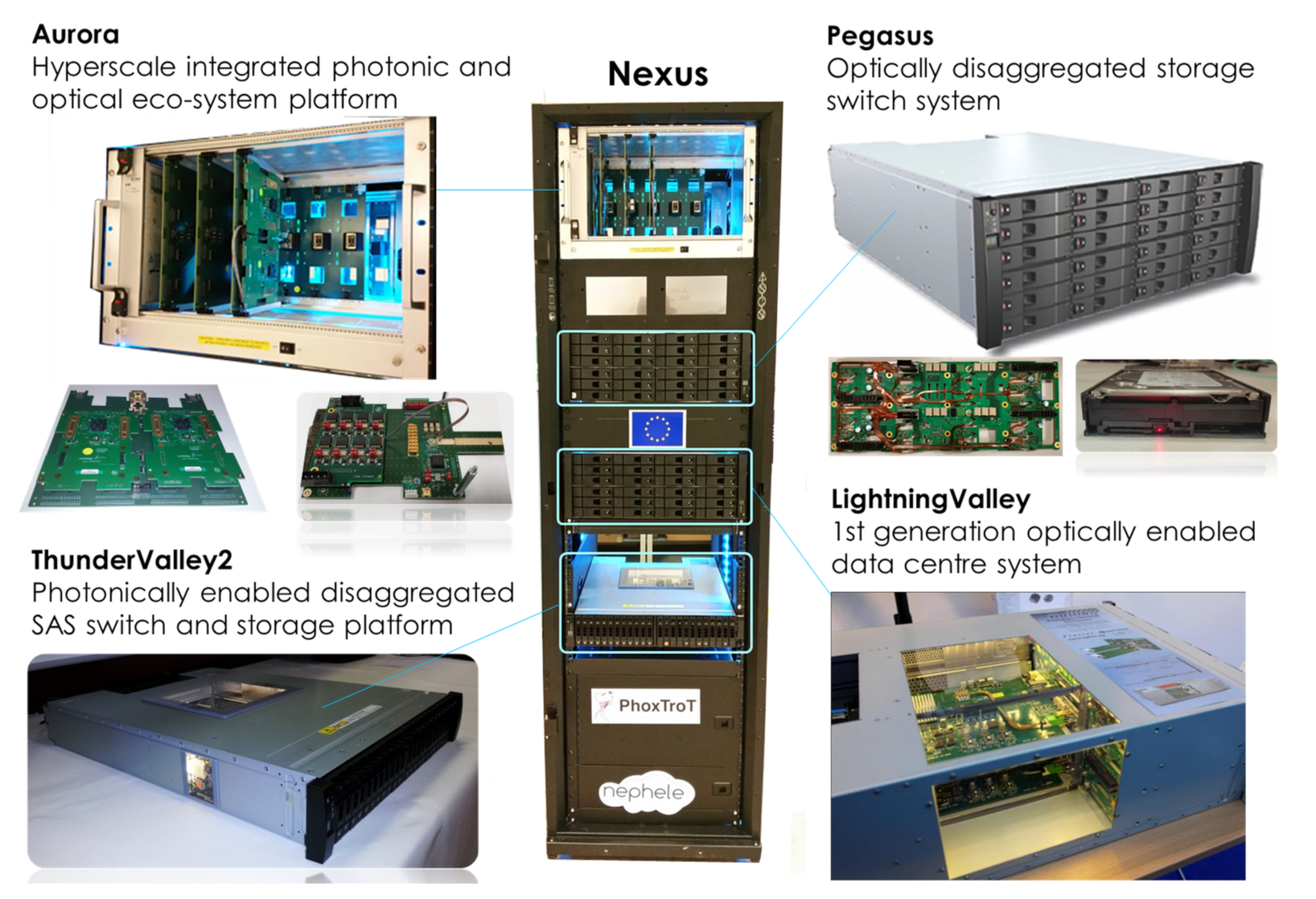
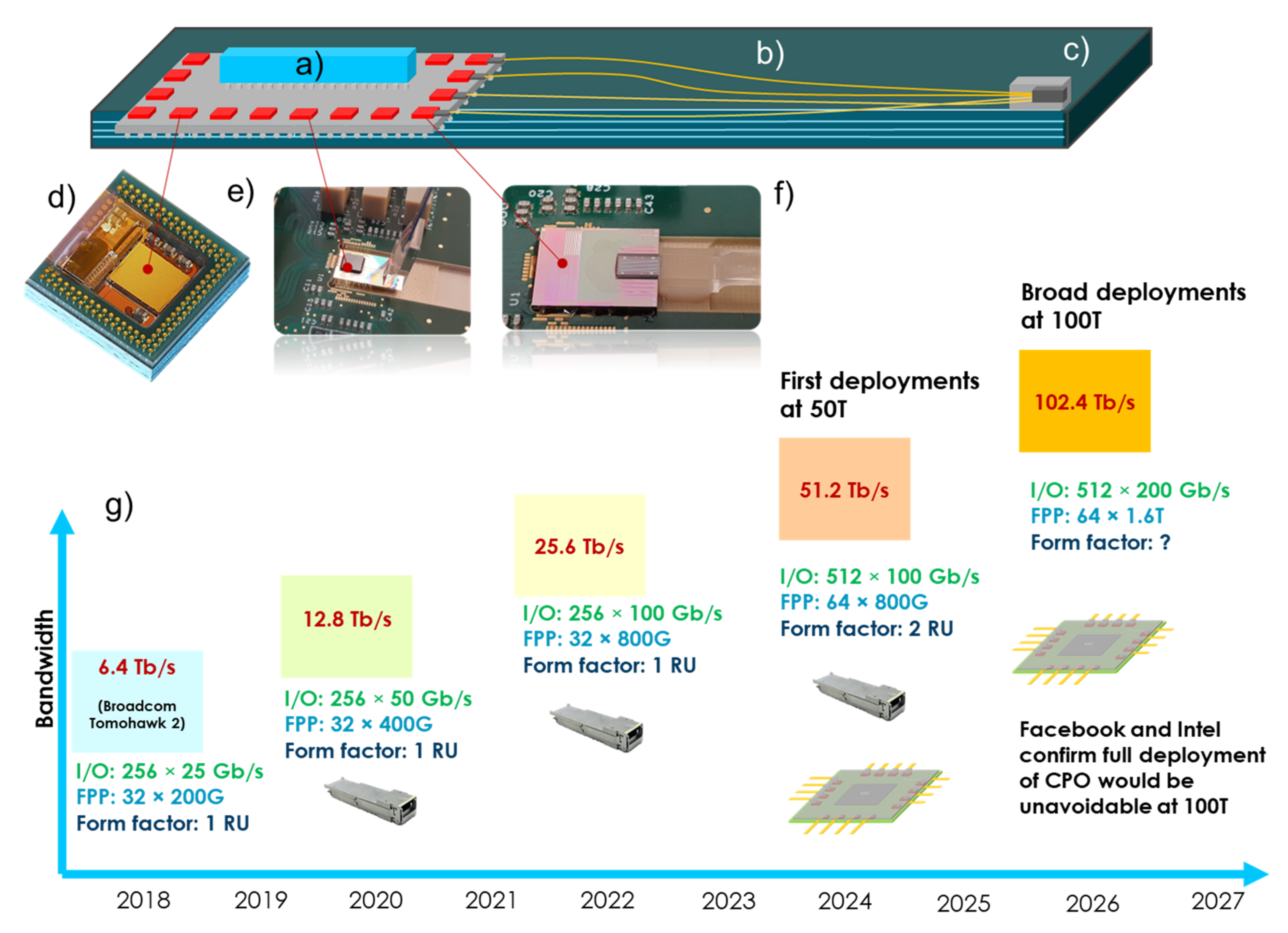
| System Designation | Communication Protocol for System/ Current (Reported) Protocol Generation/ Next Protocol Generation | System Cards/Modules | Bisection Optical Bandwidth for Current Generation/Next Generation |
|---|---|---|---|
| LightningValley2 | Serial Attached SCSI (SAS)/ SAS3 = 12 Gbps/ SAS4 = 24 Gbps | SAS switch controller (2) 3.5″ hard disk drives (24) Midplane (1) | 144 Gbps/288 Gbps |
| ThunderValley | Serial Attached SCSI (SAS)/ SAS3 = 12 Gbps/ SAS4 = 24 Gbps | SAS switch controller (2) 2.5″ hard disk drives (24) Midplane (1) | 288 Gbps/572 Gbps |
| Pegasus | Ethernet/ 10 GbE = 10 Gbps/ 25 GbE = 25 Gbps | SAS switch controller (2) 3.5″ hard disk drives or 3.5″ microservers (24) Midplane (1) | 240 Gbps/600 Gbps |
Publisher’s Note: MDPI stays neutral with regard to jurisdictional claims in published maps and institutional affiliations. |
© 2022 by the authors. Licensee MDPI, Basel, Switzerland. This article is an open access article distributed under the terms and conditions of the Creative Commons Attribution (CC BY) license (https://creativecommons.org/licenses/by/4.0/).
Share and Cite
Pitwon, R.; Reddy, A.; Jain, A.; Gomez, K.; Schulz, S.A.; O’Faolain, L.; Wang, K.; Miller, A.; Davies, V. Evolution of System Embedded Optical Interconnect in Sub-Top-of-Rack Data Center Systems. Appl. Sci. 2022, 12, 1565. https://doi.org/10.3390/app12031565
Pitwon R, Reddy A, Jain A, Gomez K, Schulz SA, O’Faolain L, Wang K, Miller A, Davies V. Evolution of System Embedded Optical Interconnect in Sub-Top-of-Rack Data Center Systems. Applied Sciences. 2022; 12(3):1565. https://doi.org/10.3390/app12031565
Chicago/Turabian StylePitwon, Richard, Anil Reddy, Aditya Jain, Kevin Gomez, Sebastian A. Schulz, Liam O’Faolain, Kai Wang, Allen Miller, and Vivienne Davies. 2022. "Evolution of System Embedded Optical Interconnect in Sub-Top-of-Rack Data Center Systems" Applied Sciences 12, no. 3: 1565. https://doi.org/10.3390/app12031565
APA StylePitwon, R., Reddy, A., Jain, A., Gomez, K., Schulz, S. A., O’Faolain, L., Wang, K., Miller, A., & Davies, V. (2022). Evolution of System Embedded Optical Interconnect in Sub-Top-of-Rack Data Center Systems. Applied Sciences, 12(3), 1565. https://doi.org/10.3390/app12031565







